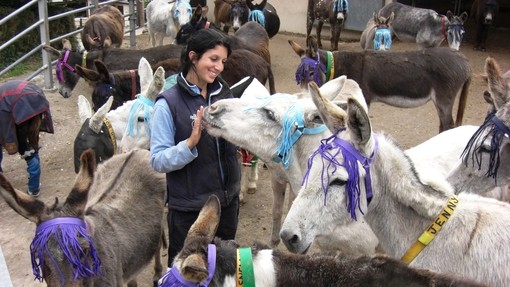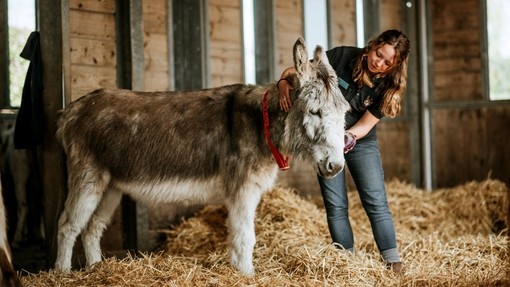What are lice?
Lice are small, parasitic insects. There are lots of different types of lice, the most common to affect the donkey is a type of ‘chewing louse’.
Lice live beneath the hair, where they feed on the donkey’s skin and lay eggs. They are passed on to other donkeys when they come in to close contact and can be extremely itchy.
Different types of lice look different. Adult chewing lice and eggs can be seen with the naked eye.
Part the hair carefully to check for lice. The best place to check is behind the elbow because it is a common site for lice and the hair is thinner and easier to part.
When donkeys have lice it is important to try to manage them, as itching in certain individuals can become so bad that they rub themselves and create sores.
How can I get rid of lice?
Controlling lice can be challenging, especially in homes with multiple donkeys.
Most lice can be killed with licenced chemical products that are applied to the skin in the form of a diluted ‘wash’. There are different treatments and your vet can give you advice on the best one to use.
The Donkey Sanctuary have found that some lice found on donkeys in our herd appear to be ‘resistant’ to a chemical called Deosect, that is commonly used to treat chewing lice in equines. A topical 5% tea tree oil product called ‘Equine Nit Nat’ is an effective alternative, although it acts in a different way.
Clipping and bathing your donkey can be an effective alternative to using chemical baths.
- Removal of long hair with clippers will allow the shampoo to reach the skin. Bathing with shampoo can work by drowning the adult lice and killing them. Lice eggs can still remain viable and so your donkey will need a repeat bath after a couple of weeks, by which time any eggs will have hatched but not had time to lay further eggs.
- Shampoos claiming to be anti-parasitic tend to have very low levels of the active ingredient and this can have the effect of promoting resistance to the effects of the product. Therefore it is best to use a perfume-free baby shampoo, which is not too harsh to cause damage to your donkey’s eyes and sensitive tissues.
Donkey rugs, grooming tools and tack should all be thoroughly washed as well to ensure they are free of eggs or adults and do not reinfest your donkeys.
How to bathe your donkey
The key to successful bathing is to be prepared, take your time and reassure your donkey at all times. Collect your equipment and decide where you are going to bathe your donkey.
You will need:
- Several watering cans with a rose type sprinkler head or a hose with hot and cold water
- Several large old bath towels and one small towel for the ears and face area
- A hose connected to the water supply, close at hand
- Two small sponges (baby sponges are ideal) or cup for the ears and face
- Preferably a friend/family member to help occupy and reassure your donkey and to run and get more water.
Always use warm water except in extremely hot weather.
- You may need a friend or family member to help occupy and reassure your donkey during the bath.
- Wet the donkey’s body all over, preferably using a watering can with a rose type sprinkler head or a hose from mixer taps with hot and cold water. Pour the water slowly to introduce this to your donkey slowly and give them time to become used to it. Do not drench in one go and leave the head and ears to last.
- Use the shampoo sparingly and massage into the body. Remember the more you use the more there is to rinse. Start from the neck down, paying attention to the mane, the withers, the armpits and the groin area; these are the common areas for lice.
- Use a small sponge to wet the face and areas behind the ears and hollows above the eyes; this is another common site for lice. Use your spare hand to protect your donkey’s eyes.
- Squeeze a little shampoo on to the sponge and work the shampoo into these areas.
- With clean warm water, rinse your donkey thoroughly, use a clean sponge or small cup for their ears and face area. Do not get water in your donkey’s ears.
- Pat your donkey dry using old towels, this is the bit that your donkey will enjoy. Use a small towel and dab gently to dry the ears and face.
Remember to give lots of praise once you have finished bathing your donkey.
Some donkeys appear to be affected much more severely by the presence of lice than others. If they are very itchy or the lice don’t seem to be treated by clipping and bathing, you should contact your vet for advice.




